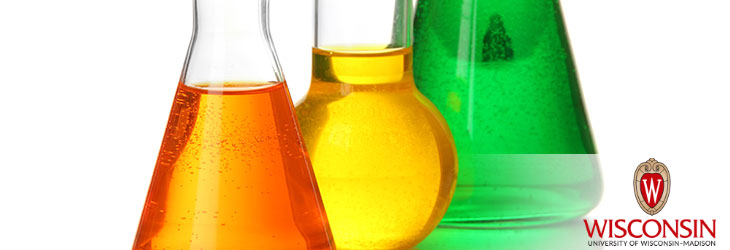Materials & Chemicals

A Photopatternable Layer for Controlling Block Copolymer Microdomain Orientation
WARF: P09005US
Inventors: Padma Gopalan, Eungnak Han
The Wisconsin Alumni Research Foundation (WARF) is seeking commercial partners interested in developing a polymer film and method for controlling the orientation of block copolymer (BCP) arrays.
Overview
The lithographic process is one of the key enabling technologies of the digital electronics era. Lithography allows hundreds of millions of components to be fabricated on a single chip with pattern features as small as 50 nanometers. However, as electronic devices become smaller and more complex, new materials and techniques that can reduce feature sizes are needed.
Block copolymer (BCP) lithography has emerged as a promising tool for further miniaturizing the masks used to make hard drives and other electronic devices. BCPs self-assemble into well-defined, highly regular and dense nanostructures. These periodic BCP arrays are useful for fabricating electronic devices such as magnetic storage media, quantum dot arrays, photonic crystals, photovoltaic cells and nanowire transistors.
For BCP arrays to be consistent and useful, it is critical to control the orientation of BCP microdomains on substrate surfaces. However, conventional methods require a non-polar substrate surface. An improved method is needed to provide more control of BCP microdomain orientation on a variety of substrates.
Block copolymer (BCP) lithography has emerged as a promising tool for further miniaturizing the masks used to make hard drives and other electronic devices. BCPs self-assemble into well-defined, highly regular and dense nanostructures. These periodic BCP arrays are useful for fabricating electronic devices such as magnetic storage media, quantum dot arrays, photonic crystals, photovoltaic cells and nanowire transistors.
For BCP arrays to be consistent and useful, it is critical to control the orientation of BCP microdomains on substrate surfaces. However, conventional methods require a non-polar substrate surface. An improved method is needed to provide more control of BCP microdomain orientation on a variety of substrates.
The Invention
UW-Madison researchers have developed a surface modification chemistry that uses thin polymer films to control the orientation of BCP microdomains on different types of substrates.
A substrate is coated with a photo- or thermally-crosslinkable polymer film composed of three monomers. In contrast to conventional BCP structures, the film is substrate independent and does not require high temperatures to induce crosslinking. It can be ultrathin (two to six nm) to facilitate pattern transfer in bottom-up device fabrication. And if a photo-crosslinkable film is used, alternate regions of the substrate may be photo-patterned by exposing only some regions of the polymer to light.
After crosslinking is induced in the polymer film, a patterned diblock copolymer film is disposed over it. The BCPs then self-assemble into a pattern determined by the ratio of monomers in the underlying polymer film. The pattern may include BCP microdomains oriented perpendicular or parallel to the substrate surface. The domains may comprise cylinders, lamellae or other structures.
A substrate is coated with a photo- or thermally-crosslinkable polymer film composed of three monomers. In contrast to conventional BCP structures, the film is substrate independent and does not require high temperatures to induce crosslinking. It can be ultrathin (two to six nm) to facilitate pattern transfer in bottom-up device fabrication. And if a photo-crosslinkable film is used, alternate regions of the substrate may be photo-patterned by exposing only some regions of the polymer to light.
After crosslinking is induced in the polymer film, a patterned diblock copolymer film is disposed over it. The BCPs then self-assemble into a pattern determined by the ratio of monomers in the underlying polymer film. The pattern may include BCP microdomains oriented perpendicular or parallel to the substrate surface. The domains may comprise cylinders, lamellae or other structures.
Applications
- Magnetic storage media, such as hard disk drives
- Quantum dot arrays
- Photonic crystals
- Photovoltaic cells
- Nanowire transistors
- Other electronic devices, including integrated circuits
Key Benefits
- Enables control of BCP microdomain orientation on substrate surfaces, including polar surfaces
- Uses substrate independent polymer films
- Does not require high temperatures to induce crosslinking
- Compatible with well established lithography fabrication techniques
- Polymer film can be ultrathin (two to six nm).
- Amenable to large scale production
Stage of Development
The development of this technology was supported by WARF Accelerator. WARF Accelerator selects WARF’s most commercially promising technologies and provides expert assistance and funding to enable achievement of commercially significant milestones. WARF believes that these technologies are especially attractive opportunities for licensing.
Additional Information
For More Information About the Inventors
Related Intellectual Property
Tech Fields
For current licensing status, please contact Jeanine Burmania at [javascript protected email address] or 608-960-9846